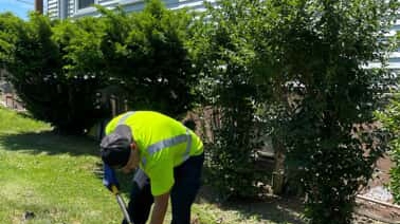Researching a home’s septic system is vitally important. Knowing there’s a septic system is a great first step, but understanding what specific kind of system helps with maintenance and repairs down the road. Here are some of the major septic systems found in homes across the country.
Conventional System
Conventional systems are one of the most common types of septic systems found in homes and can come in one of two styles, gravity and pump systems.
Gravity systems are one of the most common types of septic systems. Due to their simplicity, a conventional gravity system is a very affordable option for single-family homes or small businesses. This system transports wastewater through gravity into the septic tank.
Conventional pump systems function the same as a gravity system; however, there is more flexibility in the placement with this system. This flexibility is largely because rather than using gravity to transfer wastewater, the system uses a pump to remove wastewater from the septic tank and transport it to the leaching field, where effluent separates.
Chamber System
A chamber system is similar to conventional systems though they operate with a gravel-less drain field that often uses large open-bottomed plastic piping—leaching chambers—fitted within a trench in the ground. After passing through the septic tank and distribution box, wastewater finds its way into these leaching chambers, where it makes contact with the soil. Within the ground inside the chambers, effluent disperses, allowing for wastewater treatment before it enters the soil.
Drip Distribution System
A drip distribution system is an alternative system that uses a network of tubing to disperse effluent over a large area. This type of system typically consists of four parts which are the septic tank, pump tank, a dosing chamber, and a soil distribution area, which houses the tubes. Wastewater collects in the dosing chamber until the distribution tubing is empty and can disperse more effluent.
Because the distribution tubes are small, usually around one half inch in diameter, these systems must have a filter unit to prevent clogging of the lines. The filter unit on these systems can consist of a sand filter, a screen filter, or a disk filter. This unit is in place to prevent large debris from entering the tubing system and bringing drip distribution to a halt.
While the distribution area is more flexible because of the size of the distribution tubes, the dosing tank on this system is quite large. These systems can also require additional maintenance and electrical power, making this a more expensive option for homeowners when compared to conventional septic systems.
Aerobic Treatment Unit
The aerobic treatment unit uses oxygen to generate a biological process within the treatment system to assist in the breakdown of solid and liquid waste. These systems inoculate the treatment unit with oxygen, which then increases the natural bacteria present in the tank. Aerobic treatment units often consist of pretreatment tanks and final treatment tanks.
These tanks help in removing contaminants from the effluent before dispersing it into the environment. This type of system is common in homes where conventional systems are too space-consuming or the soil conditions cannot support a conventional system. Due to the complexity of aerobic systems, they are typically the more expensive option.
Mound System
There are many alternatives to a conventional septic system that relies on a slope to transfer effluent. If a house requires an alternative to conventional systems, this may be a great option or may already be present at the location. Mound systems are typically used when there is a high water table or if the soil depth is inadequate for conventional dispersal of effluent.
A mound system is usually a combination of a conventional pump system and a drip distribution system in that it consists of a septic tank and a pump tank that doses the leaching field. The difference is that the leaching field is a raised mound instead of a typical system of piping or tubing. The pump tank will inoculate the mound in intervals so that it distributes effluent appropriately throughout the leaching pipes within the mound.
The pipes direct effluent into the mound, where they gradually release it. The mound consists of soil, sand, and a gravel bed, which all filter the effluent to ensure it is adequately treated before it makes contact with the natural environment.
Recirculating Sand Filter System
Recirculating sand filter systems are capable of comprehensively treating wastewater and effluent more so than many other alternative septic systems. This system can often be found attached to a house in small municipalities that generate low wastewater flows. Recirculating sand filter systems, like mound systems, are great in areas with high water tables, inadequate soil depths or limited space on site. Recirculating sand filter systems perform in a way very similar to a leach field, however, on a much smaller scale.
Though this filter system is much different from conventional septic systems, like many other alternatives, a septic tank remains present. The process begins when the septic tank treats the effluent before moving into a re-circulation tank. Wastewater doses the recirculation tank and flows into the sand filter.
Sand filters function as a highly effective treatment method for wastewater when effluent pumps to the top of the re-circulation tank. Effluent is treated as it travels through the depths of sand to the bottom of the tank, where it is recirculated into the pump tank. Before recirculation, effluent can discharge from the pump tank, where it then passes into a discharge system for additional treatment.
Evapotranspiration System
An evapotranspiration system is essentially a drain field, rather than a series of networks of piping, chambers, gravel, etc. Evapotranspiration systems transport water from a septic tank to an open-air tank where it evaporates.
These types of systems are only appropriate at homes located in particular environments due to their vulnerability to failure in rain and snow events. An ideal location for evapotranspiration systems is in a geographic area with plenty of heat and sunlight.
Constructed Wetland System
Constructed wetland systems are another very unique alternative type of septic system. A constructed wetland system is a man-made recreation of the environment’s natural wetlands. These types of systems may be necessary at houses where the soil is not easily penetrated.
In this system, wastewater and effluent flow from the home into the septic tank. Once pretreated in the septic tank, wastewater flows to a wetland cell just below the surface of the ground to prevent contact with humans or animals. The cell is fitted with a solid bottom and filled with aquatic plants that can thrive under these conditions. These aquatic plants assist in the breakdown of effluent and wastewater while producing oxygen to remove nutrients from the cell.
Constructed wetland systems are sometimes built with a sump to control the water levels or effluent may continue into a drain field for continued treatment via the use of soil.
Cluster/Community System
This type of system can be found in small community neighborhoods that collect wastewater from two or more homes or businesses. Community systems can come in a few different forms depending on the environment. All community systems first take on waste in a septic tank for initial treatment. From the septic tank, multiple options are available as a drain field option in community systems.
Wastewater may exit the septic tank into a more traditional style drain field that consists of a series of gravel or stone trenches where effluent separates before wastewater enters into the soil. Alternatively, a drip distribution system may exist that consists of a series of small tubes, about one-half inch in diameter, that treat effluent and drip it into the soil for further treatment. Another option may be a constructed wetland system, where effluent flows into a wetland cell where it is treated by aquatic plants.
If you are interested in installing the best septic system for you, Wind River Environmental is here to help. With locations across 16 states, we have residential septic installation experts in cities such as Jacksonville, FL, Charlotte, NC, and Vernon, NJ. Need help finding a location near you? Contact us today and we’d be happy to connect you with our closest business.


.2504171222540.png)

